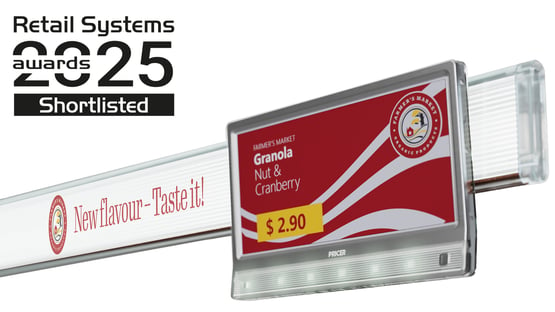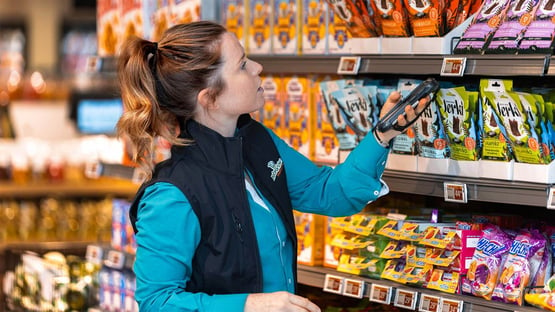Lost productivity in retail has become an issue in the face of rising labour costs, the difficulties in finding and retaining staff and a continued wave of legislation that sends costs even higher. Peter Ward, UK Country Manager at Pricer, explores how retailers can leverage technology to drive up productivity and operational efficiencies in the store.
Productivity is a critical factor in the retail industry, especially as labour costs continue to rise. Retailers are constantly challenged to maintain profitability while delivering high-quality customer service. Effective productivity strategies can mitigate these rising costs and ensure sustainable growth.
In recent years, labour costs in the retail sector have been steadily increasing. This trend is driven by several factors, including higher Minimum Wage laws, increased benefits requirements and the need to attract and retain skilled workers in a competitive market. According to the Office for National Statistics (ONS), UK labour costs in retail have risen significantly, putting pressure on retailers to find innovative ways to maintain margins.
To address these challenges, retailers must focus on enhancing productivity. By improving efficiency, retailers can reduce labour costs and improve overall operational performance.
The state of productivity in the UK
Despite the critical importance of productivity, the UK has faced significant challenges in this area. According to further ONS data, productivity growth in the UK has been sluggish over the past decade; between 2010 and 2019, UK productivity grew at an average annual rate of just 0.3%, compared to 2% in the decade before the 2008 financial crisis.
Several studies have highlighted the UK’s productivity issues, particularly in the retail sector. For example, a report by the Institute for Fiscal Studies found that UK retail productivity lags behind that of other advanced economies, such as the United States and Germany.
This productivity gap underscores the need for UK retailers to adopt more efficient practices and leverage technology to improve their operations.
Leveraging data to improve productivity
One of the most effective ways to enhance productivity in retail is through the strategic use of data. By harnessing data, retailers can optimise various aspects of their operations, from pricing and promotions to inventory management and order fulfilment.
Here are some specific scenarios where data can be used to improve productivity:

1. Switching from paper to electronic labels
Traditional paper labels in retail stores are not only labour-intensive but also prone to errors. Every time there is a price change, staff must manually update the labels, which is time-consuming and costly. Switching to electronic shelf labels (ESLs) can significantly enhance productivity.
ESLs enable instant and universal price changes, ensuring that prices are always up-to-date. This not only saves time but also reduces the risk of pricing errors, which can lead to customer dissatisfaction and lost sales.
Additionally, ESLs can be integrated with inventory management systems, providing real-time data on stock levels and helping to optimise inventory control.
2. Accuracy of promotions
Promotions are a vital part of retail strategy, but managing them can be complex and labour-intensive. Inaccurate promotions can result in lost sales, customer complaints and wasted resources. By using data analytics, retailers can ensure the accuracy of promotions and streamline their management processes.
Data analytics can help retailers identify the most effective promotional strategies, predict customer response, and optimise promotional timing. Automated systems can ensure that promotional prices are applied correctly across all channels, reducing the need for manual checks and minimising the risk of errors.
3. Compliance with planograms
Compliance with planograms is essential for maximising sales and ensuring a consistent shopping experience. However, ensuring compliance can be a labour-intensive process, often requiring manual checks.
By using data and technology, retailers can improve planogram compliance. For example, image recognition software can scan shelves and compare the layout to the planogram, identifying any discrepancies. This automated approach reduces the need for manual checks and ensures that products are always displayed correctly, enhancing the shopping experience and boosting sales.

4. Picking for online orders and replenishment
The rise of ecommerce has increased the demand for efficient order picking and replenishment processes. Manual picking is time-consuming and prone to errors, which can lead to delayed orders and dissatisfied customers. Data-driven solutions can significantly improve these processes.
Automated picking systems and Instant Flash technology, guided by data analytics, can optimise picking and routes and ensure that orders are fulfilled accurately and efficiently. In addition, real-time inventory data and Flash can help streamline replenishment processes, ensuring that stock levels are maintained and reducing the risk of stockouts or overstocking.
Innovative solutions to power productivity
In conclusion, improving productivity is essential for retailers facing rising labour costs. The UK’s productivity challenges highlight the need for innovative solutions in the retail sector. By leveraging data and adopting technologies such as electronic shelf labels, data analytics for promotions, automated planogram compliance, and efficient picking systems, retailers can enhance their productivity and maintain profitability.
The strategic use of data not only improves operational efficiency but also enhances the customer experience, leading to increased sales and customer loyalty. As the retail landscape continues to evolve, embracing these productivity-enhancing strategies will be crucial for retailers aiming to thrive in a competitive market.
Need help optimizing your productivity in your retail store? Contact Pricer and learn more.
The article was originally published in The Retail Bulletin on July 10, 2024.



